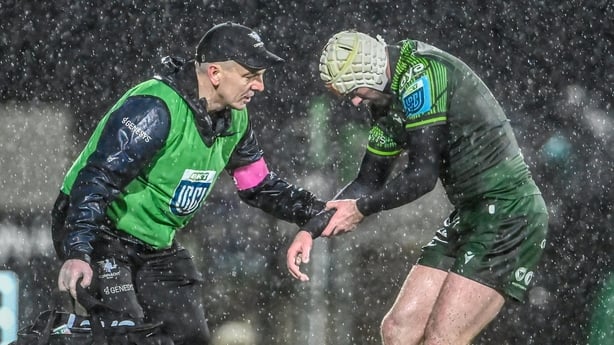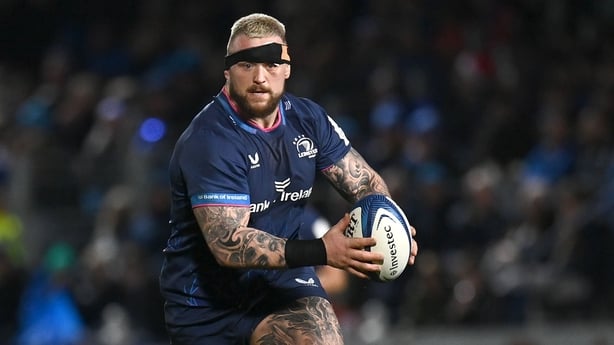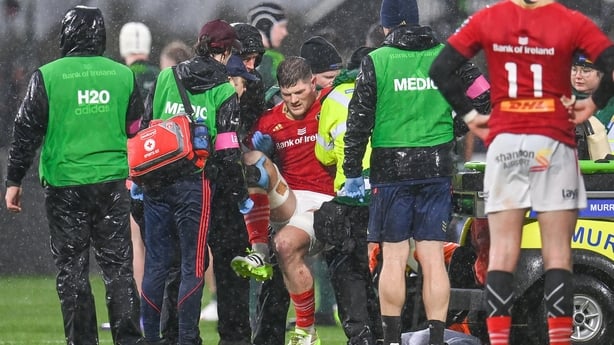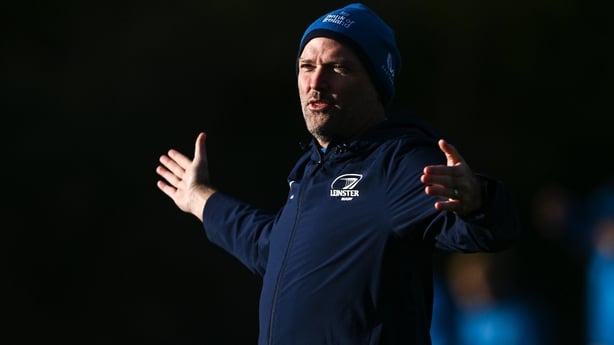He stands six foot tall and weighs in at around 19 stone but Andrew Porter still admits that putting his body on the line at the breakdown is "quite scary".
The week began with the news that Ireland star Mack Hansen would miss the Six Nations after suffering a dislocated shoulder at a ruck while playing for Connacht against Munster.
Earlier in the same game, Jack O'Donoghue was carted off in some discomfort following a clearout at a ruck that resulted in a three-game (reduced from six) suspension for Connacht's Byron Ralston.
In his weekly column, RTÉ Rugby analyst Jonny Holland wrote how his own career ended as a result of a breakdown injury.
The former Munster out-half also recalled how Dan Leavy’s playing days were effectively ended after a side-entry clearout.
Ireland lock Paul O’Connell suffered a similar fate when he was injured at a ruck during a Rugby World Cup match against France in 2015.

Donal Lenihan, the former Ireland captain and manager, said this week that rugby continues to "cannibalise itself", referring to the injuries to Hansen and Jimmy O’Brien, and Munster’s incredible list of unavailable players.
About three years ago, officials began a welcome clampdown on illegality at the ruck, quickly penalising the carrier if the ball was not released immediately. The simple move served to reduce the amount of time a jackler was exposed to a big hit.
They were "hot on it", so the expression goes.
Now the focus is on 'side-entry’ and the risk poor technique carries at the breakdown. Look at any game this weekend and you’ll see multiple examples of the grey areas in which players try to gain an advantage.
World Rugby law 15 says that "an arriving player must be on their feet and join from behind their offside line; a player may join alongside but not in front of the hindmost player, and possession may be won either by rucking or by pushing the opposing team off the ball." Bullet-pointed underneath are the instructions for the referee:
- Enforce the tackle gate and penalise side entries into the ruck.
- Encourage arriving players to drive and bind to opponents rather than diving in or tackling them.
But if there’s no injury suffered or try scored, these infringements are often quickly forgotten – on to the next ruck.
"Referees...need to penalise players that are flirting with the laws around the breakdown," said Bernard Jackman on this week's RTÉ Rugby podcast.

"It is a fine line between reckless and a big collision, especially around the ruck," Leinster and Ireland prop Porter told RTÉ Sport.
"You can have rugby incidents that happen around that area because you do have lads in compromising positions over the ball in that poach position, where you are nearly completely exposed, not knowing exactly what’s coming at you.
"If you've got your head down, you don’t know if you’ve got two 130 kilo lads coming at you.
"The weight of them pushing down on your back, it’s a tremendous amount of force coming down on your hamstring so that’s why you see things like that and injuries in that area.
"It is a fine line between aggression and controlled violence in that area.

"And then there’s that reckless side where you have lads coming from 15 or 20 metre run-ups to try and bury a lad, or coming out and coming in the side and going for the knee.
"There’s not a lot of times where it’s intentional in that area but it’s quite scary, even as a player."
Are players under undue pressure to ‘have an impact’? It’s not uncommon to hear tales of coaches hammering the importance of ‘impact on a play’, loath to see a passenger at the breakdown.
Does this then mean that even if a player gets his technique or entry wrong, they still need to do something, that, in all likelihood, they’ll probably get away with and even earn a star in the Monday review – be it for a slight jersey pull, untying a bootlace, something, anything to slow the ball down.

Double World Cup-winning coach Jacques Nienaber (above) is clear about his feelings. The senior coach at Leinster, whose side host Stade Francais in the Champions Cup tomorrow, wants a clampdown.
"Coming in technically correct is important, especially for the safety of the game," he stresses.
"That would be the preference and you should be sanctioned if you are not technically correct. You can be as physical as you want as long as you are technically correct.
"Hopefully he won’t get away with it [if he’s illegal]. I don’t see that it would be beneficial to the game if you are allowed to apply pressure illegally at the breakdown, to slow it down.
"You should be sanctioned."
Rugby bosses, who are currently trying to deal with head injury prevention, need to ensure that illegal rucking is the next thing they are ‘hot on’.
There’s too much at stake not to.
Listen to the RTÉ Rugby podcast on Apple Podcasts, Spotify or wherever you get your podcasts.
Watch Leinster v Stade Francais in the Champions Cup on Saturday from 4.45pm on RTÉ2 and RTÉ Player, follow a live blog on www.rte.ie/sport and the RTÉ News app and listen to live commentary on RTÉ Radio 1.


